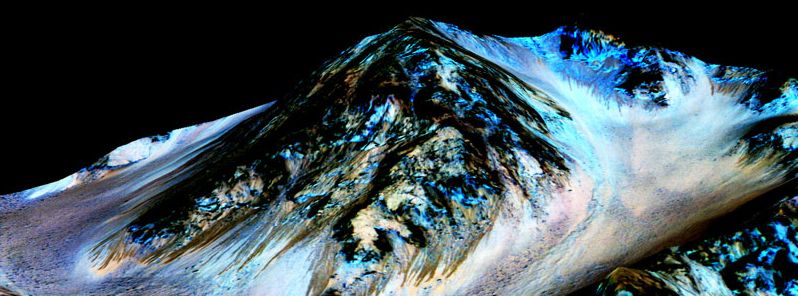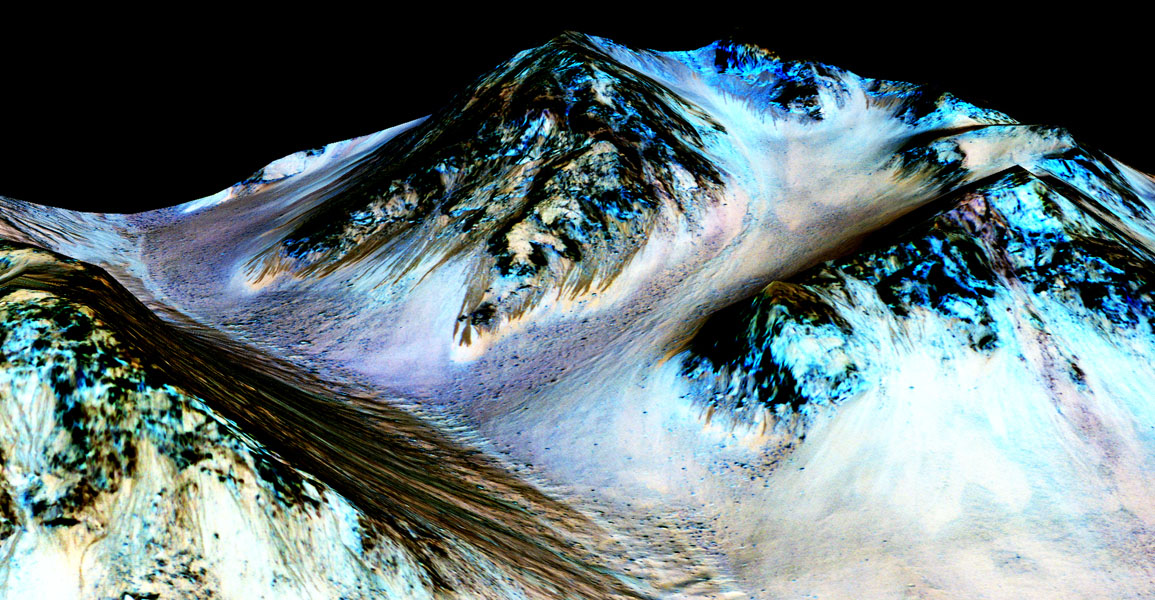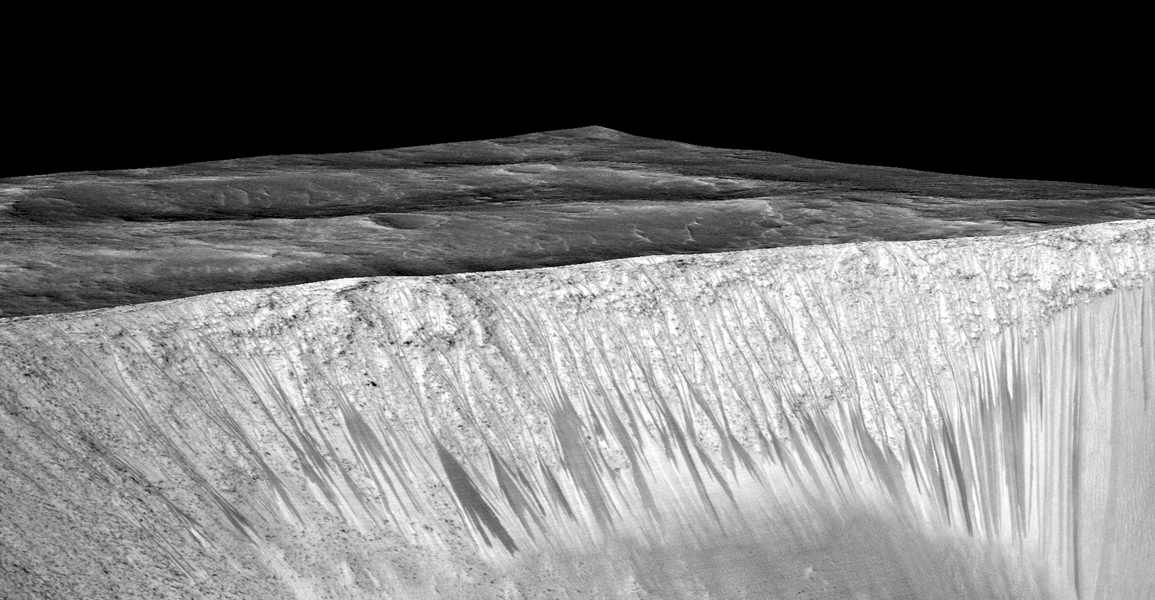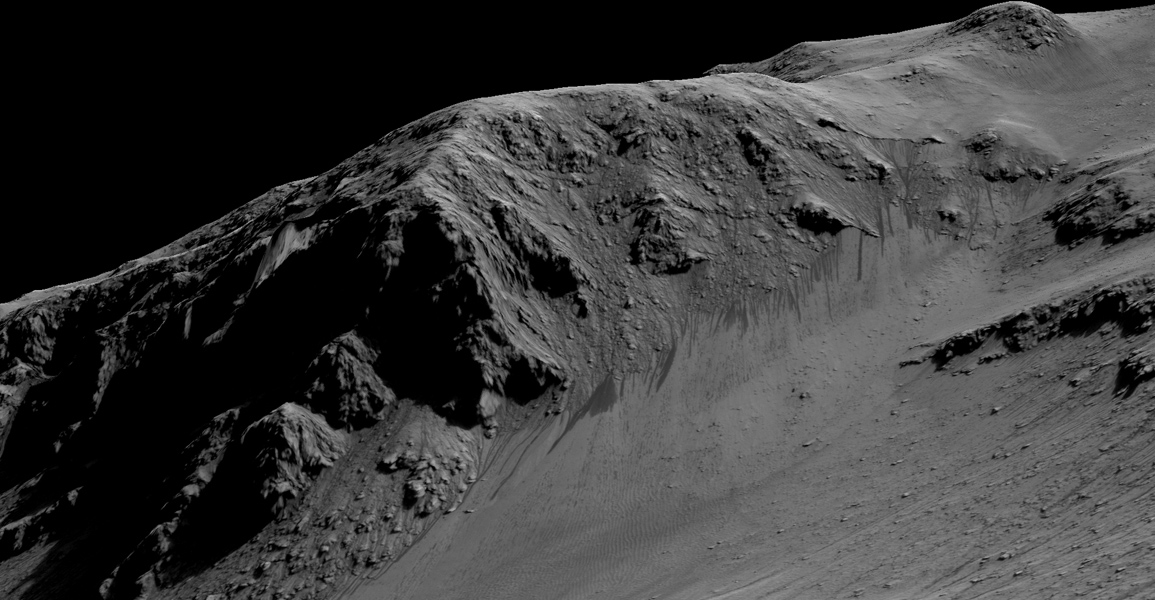NASA confirms liquid water flows on Mars

The strongest evidence so far, provided by NASA's Mars Reconnaissance Orbiter (MRO) confirms that liquid water flows intermittently on Mars, NASA stated in their public announcement on September 28, 2015.
NASA's MRO has provided new data, proving the existence of liquid water on present-day Mars.
Scientists have detected signatures of hydrated minerals on slopes crossed by dark streaks which appeared to have been ebbing and flowing over time. The minerals look as if they flow down the steep slopes during warm seasons, and then fade away later during colder seasons. They have showed up on several locations when temperatures were above – 23 ºC (- 9.4 ºF), and disappeared when temperatures decreased.

Video credit: NASA JPL
"Our quest on Mars has been to 'follow the water,' in our search for life in the universe, and now we have convincing science that validates what we've long suspected. This is a significant development, as it appears to confirm that water — albeit briny — is flowing today on the surface of Mars," said John Grunsfeld, astronaut and associate administrator of NASA's Science Mission Directorate in Washington.
Downhill flows, known as recurring slope lineae (RSL) have often been thought to be related to liquid water.The hydrated salts lower the freezing point of a liquid, causing more rapid melting. According to the scientists, detected downhill flows are most likely a shallow subsurface flow, with enough water wicking to the surface to explain the darkening.


Dark, narrow streaks on Martian slopes such as these at Hale Crater are inferred to be formed by seasonal flow of water on contemporary Mars. The streaks are roughly the length of a football field. Image credit: NASA/JPL-Caltech/Univ. of Arizona
"We found the hydrated salts only when the seasonal features were widest, which suggests that either the dark streaks themselves or a process that forms them is the source of the hydration. In either case, the detection of hydrated salts on these slopes means that water plays a vital role in the formation of these streaks," said Lujendra Ojha of the Georgia Institute of Technology (Georgia Tech) in Atlanta, lead author of a report on these findings published September 28, by Nature Geoscience.


Dark narrow streaks, called "recurring slope lineae," emanate from the walls of Garni Crater on Mars, in this view constructed from observations by the High Resolution Imaging Science Experiment (HiRISE) camera on NASA's Mars Reconnaissance Orbiter. Image credit: NASA/JPL-Caltech/Univ. of Arizona
The spectrometer has detected hydrated salt's signatures at numerous RSL locations, but only when the dark features were relatively wide.
The spectral signatures most likely belong to hydrated minerals called perchlorates. The hydrated salts are most likely a mixture of magnesium perchlorate, magnesium chlorate and sodium perchlorate. Some perchlorates are known to be able to keep liquids from freezing even when temperatures in environment reach as low as – 70 ºC (- 94 ºF). On Earth, natural perchlorates are concentrated in deserts.
Perchlorates have already been detected in the planet's soil, however, now they have been found in hydrated form in other parts of the planet as well.


The dark, narrow streaks flowing downhill on Mars at sites such as this portion of Horowitz Crater are inferred to be formed by seasonal flow of water on modern-day Mars. The streaks are roughly the length of a football field. Image credit: NASA/JPL-Caltech/Univ. of Arizona.
MRO has been examining Mars since 2006 with its six science instruments.
"The ability of MRO to observe for multiple Mars years with a payload able to see the fine detail of these features has enabled findings such as these: first identifying the puzzling seasonal streaks and now making a big step towards explaining what they are," said Rich Zurek, MRO project scientist at NASA's Jet Propulsion Laboratory in Pasadena, California.
"When most people talk about water on Mars, they're usually talking about ancient water or frozen water," Rich added. "Now we know there's more to the story. This is the first spectral detection that unambiguously supports our liquid water-formation hypotheses for RSL."
This discovery represents a significant breakthrough in NASA's long history of exploring the Red planet.
"It took multiple spacecraft over several years to solve this mystery, and now we know there is liquid water on the surface of this cold, desert planet. It seems that the more we study Mars, the more we learn how life could be supported and where there are resources to support life in the future," said Michael Meyer, lead scientist for NASA's Mars Exploration Program at the agency's headquarters in Washington.
Source: NASA, The Abstract of the paper – Nature Geoscience
Reference:
"Spectral evidence for hydrated salts in recurring slope lineae on Mars" – Lujendra Ojha, Mary Beth Wilhelm, Scott L. Murchie, Alfred S. McEwen, James J.Wray, Jennifer Hanley, Marion Masse, Matt Chojnacki – Nature Geoscience (2015) – doi:10.1038/ngeo2546
Featured image: Animation of Site of Seasonal Flows in Hale Crater, Mars. Image credit: NASA JPL

Commenting rules and guidelines
We value the thoughts and opinions of our readers and welcome healthy discussions on our website. In order to maintain a respectful and positive community, we ask that all commenters follow these rules.